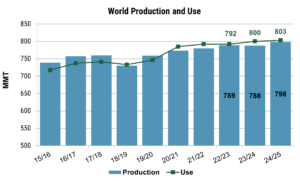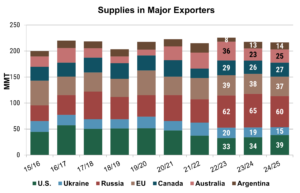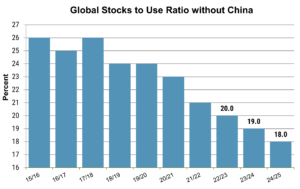Topping off a volatile, weather driven week, the May World Agricultural Supply and Demand Estimates (WASDE), released on May 10, 2024, forecast a tighter global wheat balance sheet and decreased production in several major wheat exporting countries. Moreover, USDA foresees factors that contribute to bullish market sentiment. It expects both world production and consumption to reach record levels in 2024/25, with consumption outpacing production for the sixth time in the past seven years.
The recent updates supported an already bullish market sentiment. From April 18 to May 10, Chicago Board of Trade wheat futures jumped from $5.53/bu to $6.63/bu on the day of the report’s release, and on May 28 July CBOT futures were up over $7.00/bu. The following highlights key factors to watch from the initial 2024/25 estimates and outlines the potential implications for the new crop.

Mixed Outlook in Major Exporters
The outlook for production levels in major exporting countries is variable for 2024/25. The May WASDE projects an increase in total wheat production; however, production in major exporting countries stays relatively steady, declining by just 200,000 MT to 321.0 MMT.
Following reports of dryness and potential frost damage in Russia, USDA decreased Russian production to 88.0 MMT, the lowest level since 2021. Similar weather-related issues led to a 2.0 MMT decrease in Ukrainian wheat production to 21.0 MMT. USDA also lowered EU production estimates by 2.2 MMT year-over-year to 132.0 MMT as heavy rains and flooding degrade crop conditions, particularly in major exporter France, contributing to bullish market factors.
Nevertheless, increased production in the United States, Canada, and Australia offset the reductions. U.S. wheat production estimates sit at 50.6 MMT, up 1.3 MMT from last year, but 1.1 MMT below the USDA Outlook Forum estimates. Canadian production increased 2.1 MMT to 34.0 MMT on normalized weather, while Australian production rose 3.0 MMT to 29.0 MMT in anticipation of an upcoming La Niña weather event.
Notably, India and China registered the largest production increases, at 3.5 MMT and 3.4 MMT, respectively; however, their output does not influence exportable supplies.

Tighter Stocks in 2024/25
The initial outlook for the 2024/25 balance sheet points to a bullish market trend. Global wheat consumption may exceed production by as much as 4.2 MMT, further tightening stock levels. As a result, 2024/25 ending stock level estimates decrease to 253.6 MMT, a 4.2 MMT reduction from the year prior, and the lowest level since 2015/16. Major exporter ending stocks are forecast 8% lower at 52.6 MMT, while the global stocks-to-use ratio, excluding China, is expected to tighten to 18%, down 1 point from the year prior and the lowest since 2007/08.

Stay Tuned for Updates
Looking ahead to marketing year 2024/25 and beyond, the weather and global production outlook will ultimately dictate wheat availability and quality, while a continued decline in world-ending stocks may have a bullish market influence on future price trends.
However, in the short term, prices will stay volatile in response to rapidly changing conditions and news. As always, it is important to remember that the May estimates are the initial projections for 2024/25 and are subject to change as more information becomes available. In July, USDA will release the first estimates for U.S. wheat production and exports by class, in addition to more detailed global production information. As the Northern Hemisphere harvest continues, U.S. Wheat Associates (USW) remains dedicated to providing dependable and up-to-date information for buyers, millers, and end users alike.
By USW Market Analyst Tyllor Ledford.


